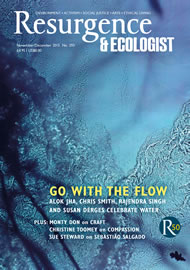“I take the path from the main road at the top of the dingle which begins in the tangle of nettle and bramble at a broken stile.” So Paul Evans begins his meditations on the natural world in which he weaves evocative descriptions of landscape and its creatures with myth, literature, science, folklore and his own “raw intuitions”. He laments the disappearance of lapwings from the fields below Wenlock Edge while delighting in the swarming of flying ants – called pismires, because their colonies are drenched in formic acid and smell of urine.
This book is poised between Evans’ love of a Nature that is “inspiring yet intimidating, miraculous yet mundane” and his fear of what is happening to it – the book is “a work of dark wonder”. Ecophobia, he fears, was built into the origins of civilisation, and now “a Nature we don’t like is replacing the Nature we do.” His purpose is to witness the miracles the world offers us and attempt to articulate them. This is surely the purpose of all Nature writing at this time of ecological crisis: describing what one finds with love and passion is a political and spiritual act.
And how well he does it. His descriptions are both acute and informed: the call of the chiffchaff “echoes the left–right of old nailed boots on stone”; a wren flies past “singing a five-second burst of little bells falling down a well”; the trickle of rain down ruined masonry tastes “musty and sharp on the tongue”. We are held alongside him as he walks along the Edge; explores quarries, ruins, caves; visits the seaside, the wild marshes; flies across the Atlantic. In all these marginal places we are shown how wilderness is “hidden in plain sight”.
The book is organised around a series of themes – Ridge, Front, Strand, Ruin, and so on – weaving between observation and reflection while drawing on extended metaphors. For example, in chapter four, a visit to a derelict cottage sets off reflections on the paradoxical attraction of ruins, on the immutable green of the ferns, mosses and liverworts that envelop it, on their origin in the Carboniferous period and their transformation into coal. From there the story slips down to the coast and into the natural history of the limpet, the “rock licker”, and on again into an account of the ruin brought along the coastline by the wreck of the tanker Sea Empress – spilling oil that, mysteriously, has its origins in those same ancient ferns and mosses. We continue through the natural history of the damselfly and a dangerous encounter with a bull, to the wild marshes of the border country. This is a land “deliberately, painstakingly and intelligently ruined” when it was drained by 19th-century landowners, ruined again by intensive agriculture, and now paradoxically ruined again as the water seeps back and it returns to something like its original state. Then we are on Islay, visiting another tract of once-drained land and another ruined cottage, where the last human inhabitants died alone and impoverished. Barn owls are now nesting in the roof. By the end of the chapter we may wonder where we have been taken – walking alongside Evans is never a direct path – but we have a deeper, subtler, more nuanced understanding of the qualities of ruin.
At times the writing is overwhelming in its intensity – this is not a book to read quickly. Evans tells us that his experience of Nature can have such a profound effect that he struggles to describe it. So many words – ‘sacred’, ‘magical’, ‘incredible’ – have become clichéd, as have their opposites – reports of ‘monster hurricanes’ and ‘Nature’s wrath’. Rather than hyperbole, Evans seeks an intimacy in his language: “Bearing witness, being truthful, requires emotional honesty.”
When he hits the spot, the impact on the reader is palpable, as when a sparrowhawk “flicks over the trees”, lands on a water pump and then “settles, directing its forensic gaze”. Not only is it “rare and thrilling … to find myself in that glare”: as the sparrowhawk pauses, the world itself “slows to a standstill”. In these few lines readers are taken deeply into the encounter and offered an opportunity to remember their own experiences of meeting a wild being.
At the end of the book, Evans takes us back to his place at Wenlock Edge, pockets a hazelnut that has a neat hole drilled into it by a dormouse, and leaves us with the observation that the beauty of the world lies in its ephemeral almost-nothingness. We have been in the company of a master.







